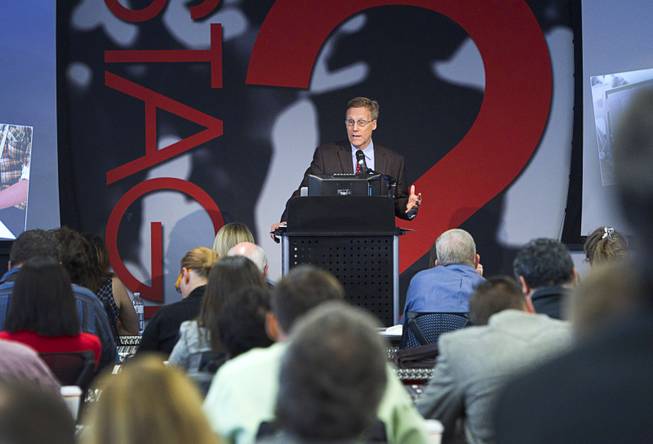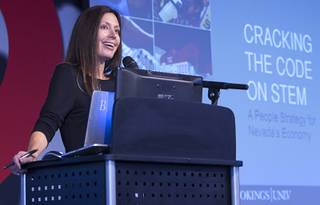
Mark Muro, Washington director of Brookings Mountain West, speaks during “Cracking the Code on STEM: A People Strategy For Nevada’s Economy” at the Innevation Center Wednesday, Nov. 12, 2014. Representatives from the Brookings Mountain West discussed a report regarding the STEM (science, technology, engineering, and mathematics) economy and education in Nevada.
Wednesday, Nov. 12, 2014 | 5:15 p.m.
How do you get ahead of the state’s shortage of qualified STEM workers? Insiders say there are two key ingredients: marketing and better education.
That seemed to be the takeaway today from a panel of five Nevada experts discussing what should be done to spark STEM growth in the Silver State in front of a packed room at the INNEVation Center coworking space, where scholars from the Brookings Institution officially released a new report titled, “Cracking the Code on STEM: A People Strategy for Nevada’s Economy.”
The report says jobs in STEM (science, technology, engineering and mathematics) are on a fast track for growth in Nevada's three budding business sectors: health and medical services, business and IT ecosystems and high-tech manufacturing. But the state just doesn't have the education programs to feed the talent pool employers pull from.
Here are five takeaways from the discussion:
STEM talent is a problem in Southern Nevada — and the state needs to recognize that.
Ask local leaders about the Silver State’s STEM status, and their answers might seem grim.
“What we have is a growing crisis that I really don’t think the state has really accepted as a serious problem, and until that happens, it’s gonna be pretty hard to solve the problem,” said Mike Kazmierski, CEO of the Economic Development Authority of Western Nevada. “Brookings has done a great job throwing up a bunch of to-do lists. It’s great, and we’ll all frantically go back and work on it for about five minutes, but this problem will not get framed or focused on or solved until it’s too late.”
So how do you fix it? Raising awareness and clearly defining what’s holding Southern Nevada back: “Once we understand the problem, solving the problem is a whole lot easier,” Kazmierski said.
If that doesn’t happen, mega companies will continue to pass over Southern Nevada as the place to do business.
“High-valued, knowledge-based companies are mobile. They can select many different locations to do business in. They select communities that have an abundant STEM-educated workforce,” said Jonas Peterson, COO of the Las Vegas Global Economic Alliance. “The workforce component is not one of many factors anymore, it is at the top of their list. If fact, if we do that right, we can overcome other obstacles.”
Make STEM students a priority in the education system.
Peterson put it this way: “STEM students are the rock stars of our educational system.”
The problem? Our culture does not view them that way. For years the education system has identifying athletes and high-IQ students as the winners, “rolling out the red carpet for them,” Peterson said.
The solution? Changing the culture and celebrating the work STEM students are doing: “We need to reward those who participate in those programs,” Peterson said.
Give STEM teachers an incentive to stay in Southern Nevada.
Sure, the students can be rock stars — but they wouldn’t be anywhere without their teachers. That’s why schools need to do everything they can to retain teaching talent.
“I think our STEM teachers are also rock stars,” said Allison Serafin, vice President of the Nevada State Board of Education. “People leave managers — they don’t always leave jobs. And we have to do a better job making sure the [talent stays].”
Serafin said financial incentives like signing and retention bonuses could help that cause.
Don’t rely on the private sector to change the world.
While the private sector might care about the lack of STEM talent in Southern Nevada, that doesn’t mean they’re going to do anything about it.
“They could care a lot and go out of business, and they’re there to do business,” Kazmierski said. “And that’s the bottom line.”
A STEM-centric marketing campaign could do a lot.
Las Vegas and Orlando, Fla., are the only two top-50 metropolitan areas where the chief export is hospitality and leisure, according to the Brookings Institute's Mark Muro, one of the report’s authors.
Their marketing campaigns focus on the thrills of the Las Vegas Strip and Disney World. But economic development and education officials say there needs to be an alternative campaign that focuses what makes these communities ripe for STEM jobs.
“We can and we should market our area as a destination for STEM educated workers, so they come to us. Other communities have done this successfully. We’re a little bit behind the curve, but we can do this,” Peterson said. “The challenge is to get them to think about our location as a place where they can live, work and play.”


Join the Discussion:
Check this out for a full explanation of our conversion to the LiveFyre commenting system and instructions on how to sign up for an account.
Full comments policy